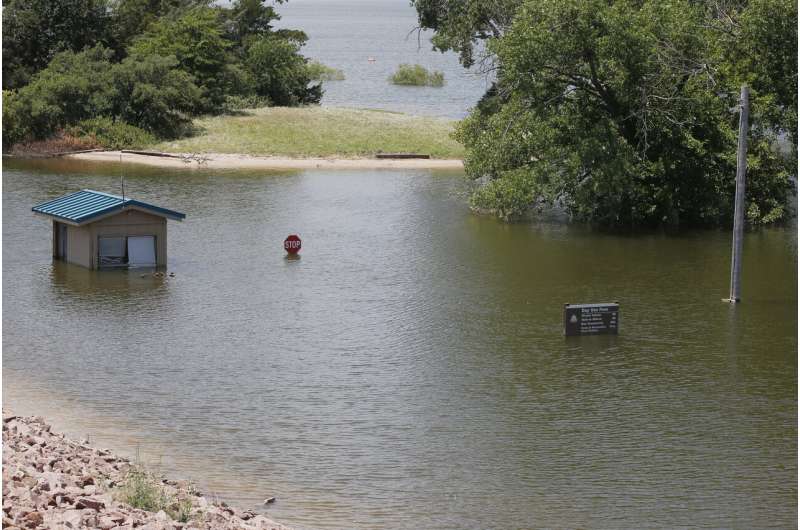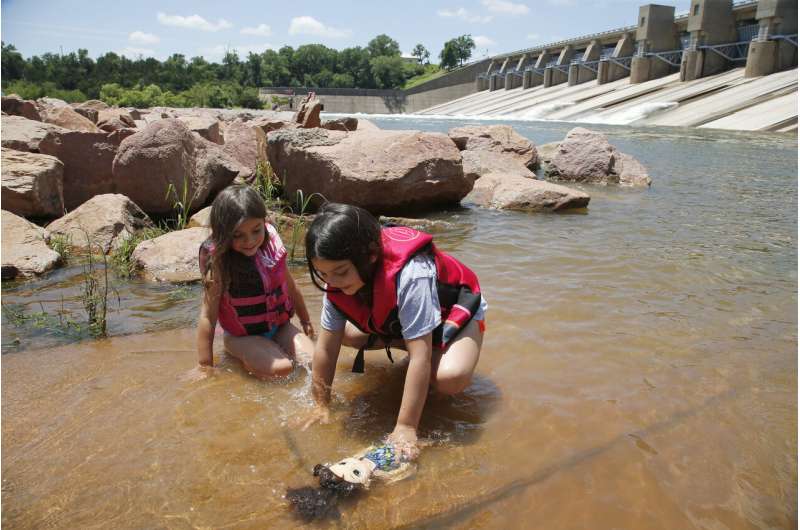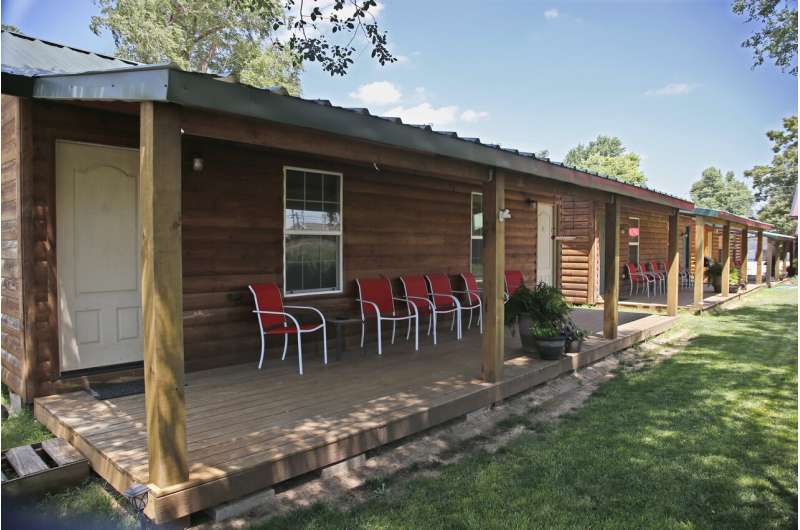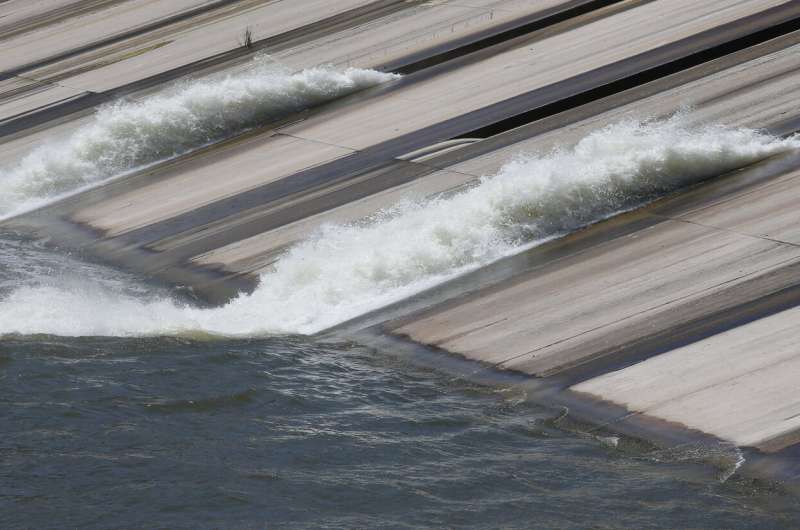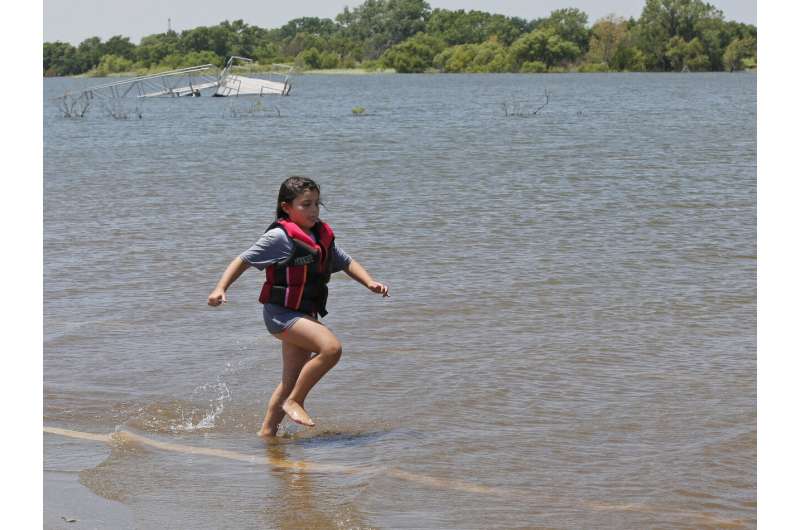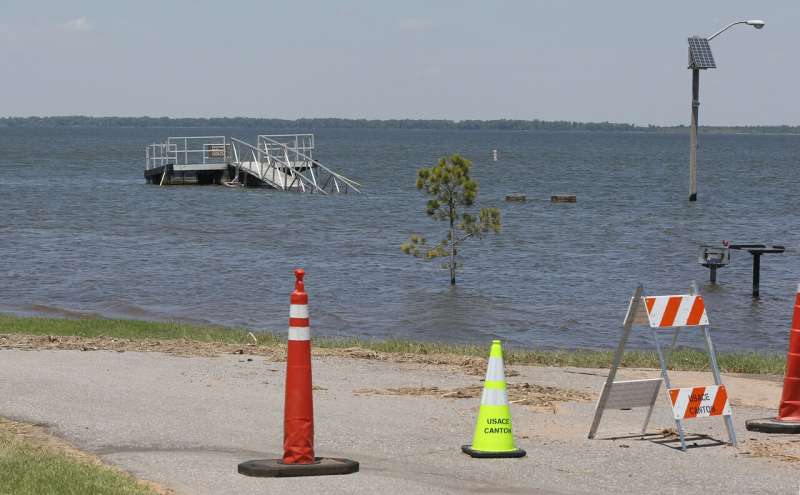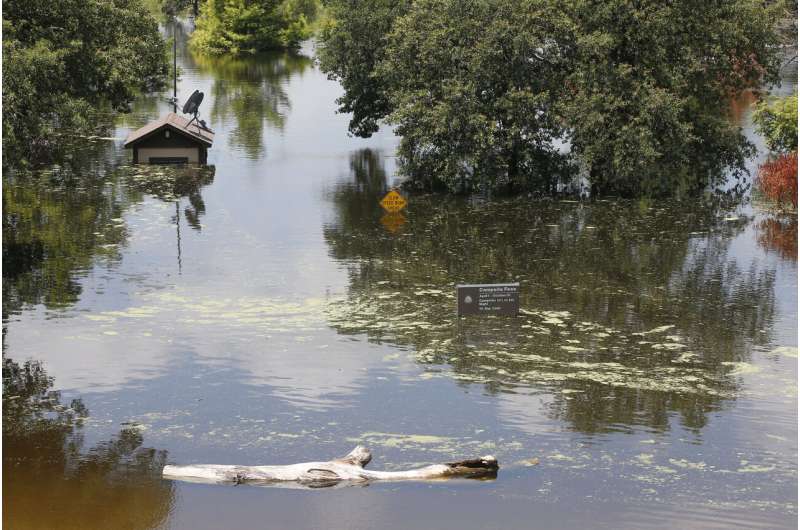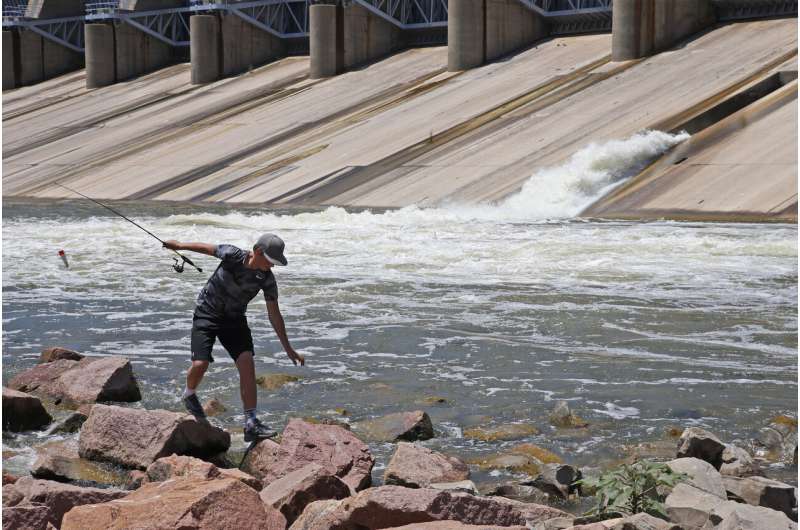Sandy Cove Beach and a nearby campground are closed due to flooding at Canton Lake in Canton, Okla., Monday, July 1, 2019. The heavy rains that caused severe flooding in the central U.S. this spring also had the positive effect of lifting the Southern Plains out of a prolonged drought. (AP Photo/Sue Ogrocki)
The rooms at Crappie King Cabins near northwestern Oklahoma's Canton Lake were mostly empty when much of the state and the rest of the Southern Plains were in the grip of a prolonged, withering drought that sent lake levels plummeting.
"Our business was really down, it sure was," said Donnie Jinkens, who owns the group of cabins named for the game fish that attracts anglers to the popular recreational lake. "We were really struggling for a long time."
But Jinkens is reeling in the lodgers these days after one of the wettest springs on record pushed Canton Lake, about 90 miles (145 kilometers) northwest of Oklahoma City, 10 feet (3 meters) above its normal level, with some campgrounds, beaches and ramps still closed. The rain caused severe flooding throughout the Midwest but also helped alleviate drought conditions in Oklahoma, Kansas, Arkansas and most of Texas that had persisted for more than two years.
"It's helped our business. We're at least 85% full, and through the springtime we were at probably 100%," said Jinkens, adding that rooms were barely at 25% capacity during the height of the drought, even during the annual Canton Lake Walleye Rodeo, Oklahoma's oldest and largest fishing tournament, which took place before the heavy rain arrived in late May.
With Sandy Cove beach, campgrounds and boat ramps closed due to flooding, Kamee Sander, left, and Kyah Sander, right, splash in the water beneath the dam at Canton Lake in Canton, Okla., Monday, July 1, 2019. The heavy rains that caused severe flooding in the central U.S. this spring also had the positive effect of lifting the Southern Plains out of a prolonged drought. (AP Photo/Sue Ogrocki)
Since Jan. 1, Oklahoma has received an average of about 27 inches (68.6 centimeters) of rain, which is almost 8 inches (20.3 centimeters) above normal and the fourth wettest six-month period in nearly a century, according to the Oklahoma Climatological Survey.
During the drought, the U.S. Army Corps of Engineers said that in May 2018, the equivalent of 1.16 billion gallons (4.4 trillion liters) of water flowed into Canton Lake from its 7,601 square-mile (19,686 square-kilometer) drainage area. In May 2019, more than 25.8 billion gallons (97.7 trillion liters) flowed into the lake.
"There's substantially more water there now," said Preston Chastee, deputy chief of public affairs for the Corps's Tulsa District.
A row of single cabins at Crappie King Cabins near Canton Lake in Canton, Okla., are pictured Monday, July 1, 2019. The rooms at Crappie King Cabins were mostly empty when much of the state and the rest of the Southern Plains were in the grip of a prolonged, withering drought that sent lake levels plummeting. Plentiful rainfall has finally drenched the drought that parched the Southern Plains. (AP Photo/Sue Ogrocki)
The U.S. Drought Monitor, an assessment of drought conditions across the nation, indicates that Oklahoma was drought-free as of June 25. A year earlier, more than 72% of the state was experiencing some degree of drought, including 28% of the state that was in severe drought and almost 12% in extreme drought.
"Everybody has received ample rainfall," said Oklahoma's state climatologist, Gary McManus.
Heavy rainfall caused catastrophic flooding along the Arkansas River basin in eastern Oklahoma, where up to 30 inches of rain was recorded, and downriver into Arkansas. Other rivers in the central U.S., including the Mississippi, flooded periodically throughout the spring, causing billions of dollars in damage to homes, businesses and farmland.
-
Water is released from Canton Lake in Canton, Okla., Monday, July 1, 2019. Plentiful rainfall has finally drenched a prolonged drought that parched the Southern Plains. (AP Photo/Sue Ogrocki)
-
Kyah Sander, age seven, of Seiling, Okla., runs through a flooded parking lot at Canton Lake in Canton, Okla., Monday, July 1, 2019. At rear is a flooded dock at a boat ramp closed due to flooding. (AP Photo/Sue Ogrocki)
-
A boat ramp is closed and a dock flooded at Canton Lake in Canton, Okla., Monday, July 1, 2019. The heavy rains that caused severe flooding in the central U.S. this spring also had the positive effect of lifting the Southern Plains out of a prolonged drought. (AP Photo/Sue Ogrocki)
-
The interior of a double cabin at Crappie King Cabins near Canton Lake in Canton, Okla., are pictured Monday, July 1, 2019. The rooms at Crappie King Cabins were mostly empty when much of the state and the rest of the Southern Plains were in the grip of a prolonged, withering drought that sent lake levels plummeting. Plentiful rainfall has finally drenched the drought that parched the Southern Plains. (AP Photo/Sue Ogrocki)
-
Campsites at Canton Lake in Canton, Okla., are closed due to flooding Monday, July 1, 2019. The heavy rains that caused severe flooding in the central U.S. this spring also had the positive effect of lifting the Southern Plains out of a prolonged drought.(AP Photo/Sue Ogrocki)
Drought-free conditions were also reported in Kansas, which recorded its wettest month on record in May, with an average of 10.26 inches of rain, which was 240% above normal. Arkansas, too, has emerged from the drought following this spring's downpours and flooding. One year ago, almost 73% of Kansas and 69% of Arkansas were experiencing some degree of drought, according to the Drought Monitor.
In Texas, almost 96% of the state is drought-free, with only a small portion of southwestern Texas still classified as abnormally dry or in moderate drought. Last year, nearly 73% of the state was experiencing drought conditions.
Texas State Climatologist John Nielsen-Gammon, a professor of meteorology at Texas A&M University and director of the Texas Center for Climate Studies, said an El Nino weather pattern brought on by the natural warming of parts of the Pacific Ocean brought wetter-than-normal conditions to the Southern Plains and other drought-stricken areas of the southwestern U.S.
Tate Tipton, age 14, of Cross Plains, Texas, walks across the rocks while fishing below the dam at Canton Lake in Canton, Okla., Monday, July 1, 2019. The heavy rains that caused severe flooding in the central U.S. this spring also had the positive effect of lifting the Southern Plains out of a prolonged drought.(AP Photo/Sue Ogrocki)
"We still have El Nino conditions in place," Nielsen-Gammon said, increasing the likelihood of plentiful rainfall and below-average temperatures through September. Much of the central U.S. is expected to remain wetter than normal throughout the summer, according to the National Integrated Drought Information System.
"It's been so wet it helps for the summertime temperatures," Nielsen-Gammon said. "Summer temperatures will tend to be a degree or so cooler than they otherwise would be.
© 2019 The Associated Press. All rights reserved.
